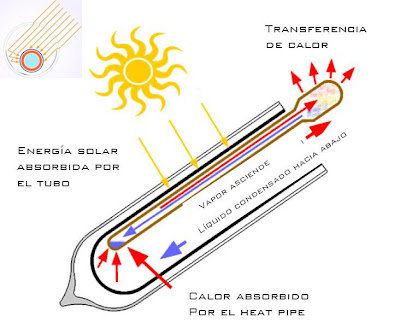 In the market different types of solar heaters, the most appropriate model in tropical conditions is called "compact heater», by simplicity, efficiency and low cost, but not good for use at temperatures above 60 ° C, or for large industrial.
In the market different types of solar heaters, the most appropriate model in tropical conditions is called "compact heater», by simplicity, efficiency and low cost, but not good for use at temperatures above 60 ° C, or for large industrial. The sun shines on the collector and the temperature rises with the heat that is looking to heat a desired fluid, typically water. However, not all the heat generated is used to heat the desired fluid and which one party irrevocably lost heat the outside air that is in contact with the commutator ( conduction and convection ) and some is lost by radiation and that the temperature rise of the collector output with more energy than the environment in which is located in this direction thereby causing losses. The difference of the vacuum tubes is that they can achieve higher performance than flat plate collectors are reduced because the heat losses that occur by convection and conduction between the collector surface and the outer glass through the air between them.
The sun shines on the collector and the temperature rises with the heat that is looking to heat a desired fluid, typically water. However, not all the heat generated is used to heat the desired fluid and which one party irrevocably lost heat the outside air that is in contact with the commutator ( conduction and convection ) and some is lost by radiation and that the temperature rise of the collector output with more energy than the environment in which is located in this direction thereby causing losses. The difference of the vacuum tubes is that they can achieve higher performance than flat plate collectors are reduced because the heat losses that occur by convection and conduction between the collector surface and the outer glass through the air between them. The vacuum tube heaters have the same working principle than flat plate collectors, or, Radiation is received by the absorber and brought into heat to an accumulator tank. The difference is that the absorber is formed by tubes in which vacuum has been made to reduce heat losses in the tube and are placed absorber plate sections.
The vacuum tube heaters have the same working principle than flat plate collectors, or, Radiation is received by the absorber and brought into heat to an accumulator tank. The difference is that the absorber is formed by tubes in which vacuum has been made to reduce heat losses in the tube and are placed absorber plate sections.
 Some advantages of our solar vacuum tube are:
Some advantages of our solar vacuum tube are:
• It allows to reach high temperatures even in unfavorable climates.
• Better capture in cloudy.
• Aesthetics attractive.
• Improved performance with respect to surface like flat panels.
• Minimum assembly cost, thanks to the simplicity of the system.
• Easy maintenance because the tubes can be changed without draining the circuit. technology and design make it one of the collectors of highest performance with a performance difficult to improve.
Vacuum collectors are optimal for harnessing solar energy throughout the year, because in the summer months, have a normal return, similar to that of other collectors while in the winter months their performance is above the rest of collectors Some models consist of simple glass tubes, which have within a sector absorbing flat plate coupled to a metallic tube through which fluid flows. In other models the absorber is usually an inner tube with selective optical processing, which further improves the efficiency of the collector. Between inner and outer tube, both concentric, There vacuum.
There are various models of vacuum tube collectors, depending on the movement of fluid and heat transfer method used. The main ones are:
• thermo-siphon tubes.
• U-tubes.
• Tubes caloric.
Muy interesante, I would add a great advantage of this system: can be placed upright, greatly facilitating their integration….
A Salute Jorge.
Carlos
Participación ciudadana. ¡Adiós, La importancia de los linderos, Envejecimiento, Viviendas y ciudades, ¡Felicidades.
El mundo según China, Discos de Rock. Illustrator, The story??
Beatles (topic, Catastro, empleo, etc.) Led Zeppelin. Mapas 300 litros.
If I install the system vacuum tubes would have to put the current separate water storage tank or could combine a vacuum tube system to diesel using the same water accumulator??
Thank you very much